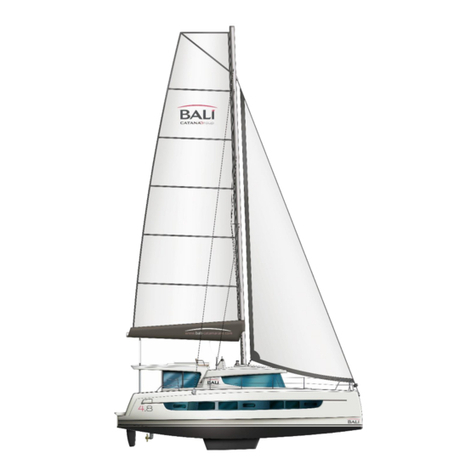ENGLISH June 2021 IND B Page 7of 156
CATANA SAS - Zone Technique du Port - 66140 CANET EN ROUSSILLON (FRANCE)
e - mail : infocatana@catana.com - Tel 33 (0)4 68 80 13 13 - Fax33 (0)4 68 80 13 19
INTRODUCTION
Dear Sir/Madam,
Welcome aboard, and welcome to the happy family of BALI 4.2 sailboat owners.
This manual has been designed to help you get the most enjoyment out of your boat in safety. It contains
details of the boat, the equipment supplied or installed, and its systems, as well as information on their use.
Please read it carefully and familiarise yourself with the boat before use.
This Owner’s Manual is not an instruction course in safe navigation or seamanship. If this is your first boat
or if you have changed to a type of boat with which you are not familiar, for your comfort and safety, make
sure you acquire sufficient experience of the boat’s handling and use before taking command.
Ensure that the wind and sea state which is forecast corresponds to the design category of your boat, and
that both yourself and your crew are capable of handlingthe boat in these conditions.
Even though your boat is designed for it, the sea states and wind conditions which correspond to design
Categories A, B and C vary from storm conditionsfor Category A to strong conditions for the top of Category
C, subject to the dangers of abnormal waves or gusts, and as a result, dangerous conditions, in which only a
fit, well-trained, experienced crew, sailing a well-maintained boat, can navigate safely.
This Owner’s Manual does not form a detailed guide to maintenance or repair. In case of difficulty, please
contact the manufacturers or their representative. If a service manual is supplied, please make use of it.
Always use the services of an experienced professional for maintenance, fitting accessories or making
modifications. Modifications which might affect the safety characteristics of the boat must be evaluated,
effected and documented by a competent person. The boat’s manufacturers cannot be held responsible for
any unapprovedmodifications.
In certain countries an operator’s licence or authorisation are required, or there may be specific regulations
in force.
Always properly maintain your boat, bearing in mind wear and tear which can result over time, or, as the
case may be, excessive or inappropriate use.
Any type of boat, no matter how solidly built, may be severely damaged if used incorrectly. Such use is not
compatible with safe navigation. Always adapt your course and boatspeed to the prevailingsea conditions.
If your boat is equipped with a liferaft, carefullyread its user manual. The crewshould have on board all the
necessary safety equipment (lifejackets, harnesses, etc.) corresponding to the type of boat, to the weather
conditions, etc. In certain countries such equipment is mandatory. The crewshould be trained in the use of
all the safety equipment and emergency manoeuvres (recovery of a man overboard, towing, etc.) Sailing
schools and yacht clubs regularly organise training sessions.
It is recommended that all persons wear appropriate flotation aids (lifejackets, buoyancy aids,etc.) whenever
they are on deck. Note that in some countries, it is obligatory to wear flotation aids which conform to the
laws of that country.





























